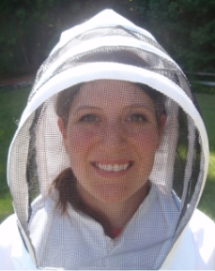Well the leaves are changing colors, the days have been getting shorter and we have been BUSY! I apologize for my drought of updates – we’ve had weddings and a vacation keeping us busy. Since its been getting cooler the number one bee question I’ve been asked lately is, “what do bees do during the winter?” I thought I’d let you all know. Its an excellent question. They certainly don’t fly south – those little wings wouldn’t make it to Rhode Island and back. Instead they pretty much hunker down in their hive, which we beekeepers have helped fortify.
As the temperatures start to drop in the fall, the bees continue collecting nectar and sap for propolis. They store the nectar and sugar syrup away as honey for winter food stores and they use the sap to make propolis. Propolis is a sticky mess initially, but it hardens to a strong orange varnish. The bees use it to fill in any cracks and holes that may make the hive drafty during the winter. During this time period the queen slows egg production and they start kicking the drones (male non-worker bees) out of the hive so they don’t have to feed extra mouths.
When the temperatures drops to the low 50’s (F) the bees form what is call the winter cluster. It is exactly what it sounds like – the bees cluster together on top of their honey stores, eat the honey and vibrate causing friction and heat. The worker bees take turn swapping from the outside of the cluster to the inside. The queen remains in the center of the cluster the entire winter where temperatures remains in the upper 90’s (F). While in the cluster she stops laying eggs until spring.
The bees pretty much take care of themselves – but aside from feeding them sugar syrup to replenish their food stores there is a bit beekeepers can do to help. To further prevent drafts, many beekeepers cover the entire hive with roofing paper. Unfortunately drafts are not the only thing beekeepers must worry about. With so much heat generated from the winter cluster, and temperatures so low on the outside of the hive condensation can form without proper ventilation. Beekeepers must insure proper ventilation for their hives or risk cold condensation dripping onto the bees and killing them. I researched a bit and discovered that some beekeepers use a product called homosote – an insulating sound-proofing material – for the top of their hives. In addition to providing insulation, the board will hold moisture caused by condensation. This prevents it from dripping back down on the bees, but allows the bees to retrieve the water when they need it.
Finally – with the warm temperatures inside the hive the bees will sometimes get freeloaders looking for warmth. While the bees normally can defend against mice and other critters during warmer weather, they can’t do much when they are vibrating to stay warm. For this reason beekeepers will add what they call a mouse guard – a metal device at the entrance of the hive that allows the bees to come and go, but is much too small for a mouse. It is important that the guard be metal since mice are known to chew through wood entrance reducers to get to the warmth inside.
Next time I’ll tell you about my lip gloss making experiment!


VERY interesting. What a tricky situation. I hope they are safe and warm all winter! Lipgloss, what? Can’t wait to read that post.